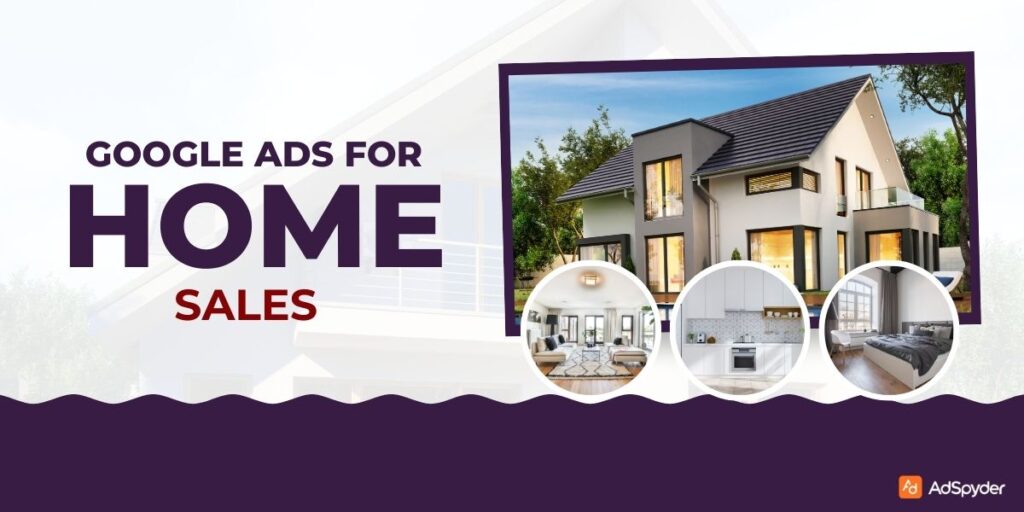The days of traditional marketing in the real estate industry are long over. Today’s buyers will hardly ask their real estate agents whether there are houses for sale. Instead, they will go on Google and search for a home, compare prices, and know how to buy a house. Google’s Ads are a revolutionary change for the realtor or seller’s end-all, be-all resourceful advertising effort, offering highly specific targeted reach on specific timing. This guide will cover everything realtors need to know about creating, optimizing, and scaling Google Ads for home sales. You will learn the best ad formats, keyword strategies, bidding techniques, and common pitfalls to avoid.
Ready to Elevate your Marketing Strategy?
Unlike traditional advertising methods, Google Ads offer data-driven insights, precise audience targeting, and flexible budget options. This ensures that real estate professionals get the most value from their marketing investment. Whether you are selling individual homes, promoting new developments, or generating leads for home sellers, Google Ads provide a powerful, scalable solution.
Why Google Ads Work for Home Sales
Many homebuyers begin their search online. According to industry reports, over 50% of home buyers start their property search on Google before engaging with a realtor. This makes Google Ads a critical tool for capturing high-intent buyers and sellers at the exact moment they are looking for properties or real estate services.
In contrast to social media marketing, where ads are shown passively in users’ timelines, Google Ads reach you directly in front of active searchers. When a person searches for “homes for sale in Miami” or “buy a house near me,” your ad can be shown at the top of the search results, making it more likely to create a qualified lead.
Google Ads also offers detailed performance tracking and analytics so that real estate agents can optimise their campaigns to yield better outcomes. You get to know precisely how many individuals have clicked your advertisement, how long they remain on your landing page, and if they made an inquiry or not. With this data-based method, advertising spending is maximized.
Key Benefits of Google Ads for Home Sales
- Targeting High-Intent Homebuyers – Your ads show up when individuals are proactively searching for homes, increasing the likelihood that they will convert.
- Location Targeting – You can target certain cities, ZIP codes, or even neighborhoods so that your ads reach the intended audience.
- Quantifiable Performance – Google Ads give you instant visibility into impressions, clicks, conversions, and ROI.
- Flexible Budgeting – Daily or monthly budgets can be set, and spend can be varied according to performance.
- Competitive Edge – If your local realtors are advertising, a good Google Ads approach means you won’t be left behind.
Best Types of Google Ads for Selling Homes

Not all Google Ads are the same. Ad formats perform best based on your particular real estate objectives. Below are the best Google Ads methods for selling homes.
1. Google Search Ads – Targeting Active Homebuyers
Google Search Ads show up on top of the search results page when users enter keywords associated with home purchasing. They are text ads that are very effective since they reach users who have high purchase intent.
How Search Ads Work for Home Sales
Search Ads are triggered by exact keywords, including:
- “Homes for sale in [City]”
- “New developments near me”
- “Buy a house in [ZIP code]”
- “Best real estate agent in [City]”
When a searcher types in these keywords, Google shows the most relevant ads, frequently placing them above organic results. This positions realtors favorably on Google’s first page, increasing visibility to potential homebuyers.
Best Practices for Search Ads
- Employ location-based keywords to make ads appear to relevant buyers.
- Create engaging ad copy that emphasizes the distinctive selling points of a property or service.
- Add a solid CTA (Call-to-Action), e.g., “Schedule a Viewing Today” or “Get a Free Home Valuation.”
- Install ad extensions, including contact details, links to individual property pages, and customer reviews.
Related – Best Facebook Ads for Real Estate
2. Google Display Ads – Increasing Visibility Across Real Estate Websites
Google Display Ads are visual ads that appear on real estate blogs, news websites, and other sites browsed by potential buyers. These ads create awareness and keep your listings in front of interested users.
How Display Ads Work for Home Sales
Display Ads use Google’s massive ad network to place graphical ads on real estate, finance, and home improvement sites. Display Ads are highly effective for retargeting people who had previously visited your site but didn’t take action.
Best Practices for Display Ads
- Use high-quality property photos to capture attention.
- Make attention-grabbing headlines such as “Luxury Homes Available in [City]” or “Find Your Dream Home Today.”
- Retarget previous site visitors with reminders about the homes they previously browsed.
- Mobile optimization, where ads appear wonderfully on every platform.
3. Google Shopping Ads – Showcasing Properties in a Visual Format
Google Shopping Ads are normally employed for eCommerce but can equally work in real estate advertising. The ads enable realtors to present images of the properties, prices, and main details in the actual Google search results.
How Shopping Ads Work for Home Sales
When someone types in “new homes for sale in [City],” they might view a carousel of home photos with prices and agent information. Tapping on the ad brings them directly to a detailed listing page.
Best Practices for Shopping Ads
- Make sure the photographs are at a high resolution, and show the property.
- Give the price, location, and availability accurately.
- Target active buyers looking for new developments and pre-construction properties.
4. YouTube Video Ads – Engaging Homebuyers with Virtual Tours
YouTube, owned by Google, is a top platform for real estate marketing. Video ads allow realtors to showcase properties in detail, creating a more immersive experience for buyers.
How YouTube Ads Work for Home Sales
Realtors can run skippable in-stream ads before real estate-related videos or discovery ads that appear in YouTube search results. Video ads are especially effective for:
- Virtual property tours that offer buyers an insider view of properties.
- Home value and trend update videos that inform buyers about home values and trends.
- Testimonial videos of satisfied customers who have used the realtor.
Best Practices for YouTube Ads
- Make videos concise and attention-grabbing (30-60 seconds).
- Add text overlays with important details such as price, location, and contact information.
- Add a CTA that tells viewers to book a viewing or visit your website.
5. Google Performance Max Ads – AI-Powered Campaigns for Real Estate
Performance Max Ads are Google’s latest ad format, leveraging AI to automatically place ads on Search, Display, YouTube, Gmail, and Maps. These campaigns real-time optimize to show ads to users most likely to convert.
Why Use Performance Max Ads for Home Sales?
- Google’s AI identifies high-intent buyers by their browsing behavior.
- Ads show on multiple Google properties, amplifying reach.
- Automated bidding allows for effective budget distribution.
Best Practices for Performance Max Ads
- Employ a combination of text, image, and video content to drive the most engagement.
- Allow Google AI to optimize targeting from real-time performance data.
- Monitor conversions to identify which placements are driving the most leads.
Related – Realtor Brand Awareness Campaigns
Setting Up a High-Converting Google Ads Campaign for Home Sales

The strategies used in marketing real estate are not all the same. A successful campaign cannot just be created with a budget and the pushing of an ad. This creation requires systematic working towards potent visualization of ideal prospects, enticing potential high-intent buyers, and conversion. Below are the most important steps in the initiation of setting up high-converting ad campaigns.
1. Keyword Research & Targeting Strategies for Real Estate Ads
Picking the most relevant keywords is the cornerstone of a successful Google Ads campaign. Google Ads operate through matching the intent of a search query made by a user and your advertisement; therefore, having high-intent keywords ensures your ad reaches actual homebuyers and sellers seeking real estate prospects.
Best Keywords for Home Sales Ads
Top-performing real estate keywords usually are:
Area – Specific Keywords:
- “Homes for sale in [City]”
- “New homes in [Area Code]”
- “Condos for sale near me”
Property Type Keywords:
- “Luxury homes for sale”
- “Townhouses for sale in [City]”
- “Waterfront properties in [City]”
Buyer Intent Keywords:
- “Best neighborhoods to buy a house”
- “First-time homebuyer guide”
- “How to buy a house in [City]”
Seller Intent Keywords:
- “How to sell my house fast”
- “Best realtor in [City]”
- “Home valuation near me”
Long-Tail vs. Short-Tail Keywords
Long-tail keywords like (e.g., “4-bedroom homes for sale in Miami with pool”) possess lower competition and better conversion ratios than short-tail keywords (e.g., “homes for sale”), which are costlier and competitive in nature.
📌 Example:
Instead of going after “homes for sale”, a more productive keyword will be “3-bedroom homes for sale in Atlanta under $400K”.
2. Using Negative Keywords to Avoid Wasting Ad Spend
Negative keywords keep your ad from appearing for irrelevant searches. For example, if you’re selling luxury homes, you wouldn’t want your ad to appear when someone is looking for “cheap apartments” or “foreclosure homes.”
✔ Common negative keywords to exclude for home sales ads:
- “Free” (e.g., “free homes” or “free house listings”)
- “Rent” or “rental” (unless you sell rental services)
- “Zillow or Realtor.com” (in case you prefer not to auction on listing sites)
- “tiny house” or “mobile home” (unless they fall under your specialty)
📌 Example:
If you are selling new construction residences, including “foreclosures” or “used homes” as negative keywords means your funds won’t be wasted on extraneous searches.
3. Geo-Targeting: Reaching Buyers in the Right Location
Geo-targeting ensures that your ads appear only to potential buyers in specific locations. Since real estate is location-sensitive, narrowing your audience by city, neighborhood, or ZIP code increases lead quality.
Best Geo-Targeting Strategies for Home Sales:
- Target users searching in specific ZIP codes or neighborhoods.
- Expand your reach to out-of-state buyers looking to relocate.
- Adjust bids based on which areas generate the highest conversions.
📌 Example:
A real estate agent in Houston might set their ads to only show to users within a 25-mile radius, ensuring they reach serious buyers in the local market.
Explore It – Retargeting Strategies for Property Buyers
4. Writing Effective Ad Copy That Converts
No matter how effective your targeting and keywords, your ad needs to stand out to attract clicks. Effective ad copy should be concise, interesting, and buyer-focused.
What Makes a High-Converting Google Ads Copy
- Headline: What people notice first. It must be engaging and pertinent.
- Description: Include important information about the property or service and a solid click reason.
- Call-to-Action (CTA): Instruct users to book a tour, request a free consultation, or browse listings.
Example of an Effective Google Search Ad for Selling Homes
Headline: Miami Luxury Homes For Sale Starting at $500K
Description: Tour gorgeous 3-5 bedroom Miami homes in best areas. Arrange for a private tour now. Inventory is limited!
CTA: View Listings Now
📌 Why This Works:
- Keywords are included in the headline for relevance.
- The description points to the major selling points (number of bedrooms, area, price).
- The CTA is powerful and actionable.
5. Creating High-Converting Real Estate Landing Pages for Home Sales Ads
Redirecting Google Ads traffic to an under-optimized landing page means throwing money down the drain. An optimized landing page keeps people interested and active.
What Makes a Great Real Estate Landing Page?
- A webpage that loads quickly permits buyers to avoid waiting on slow page times.
- Users should find booking consultation appointments or viewing listings as direct processes.
- The page should showcase high-quality property images along with videos.
- Mobile Optimization: Provide a smooth experience across all devices.
- The lead capture form provides a platform to collect follow-up contact details from users.
Example of an Effective Real Estate Landing Page:
- Headline: “Find Your Dream Home in [City]”
- The subheading states: “Watch exclusive property listings followed by a private site tour option.”
- CTA Button: “View Homes Now”
- This form includes a name, email, and phone number, as well as the selection option for preferred home type.
📌 Why This Works:
- The web page guides users directly to the home finding process.
- The CTA enables users to move forward to the following action (view homes).
- A lead form enables the collection of customer information, which the business team can use for contact purposes.
6. Call Extensions & Click-to-Call Ads for Instant Lead Generation
Home buyers tend to prefer talking to an agent directly over filling out a form. Having a Click-to-Call CTA in your ads allows the potential buyer to call your office immediately.
✔ Best Practices for Click-to-Call Ads:
- Run during working hours so that agents can respond.
- Utilize a trackable call extension in order to keep track of lead quality.
- Test various CTA options (“Call Now,” “Speak to an Agent,” “Book a Call”).
📌 Example:A shopper looking for “Dallas homes for sale” notices a Google Ad with CTA “Call Now for a Private Showing” and directly calls from his mobile.
Budgeting & Bidding Strategies for Google Ads for Home Sales

Running Google Ads in home sales needs to be with a well-served budget and bidding strategy. Below are fundamental strategies:
1. Understanding Google Ads Costs when Selling Homes
Google Ads are based on a pay-per-click (PPC) format, so you pay only if a person clicks your ad. Cost per click (CPC) depends upon competition, placement, and intent behind the keywords.
Average CPC for Real Estate Ads:
- $1 – $5 per click for local real estate searches.
- $10 – $30 per click for high-end markets (e.g., luxury homes in New York or Los Angeles).
- Lower CPC for specialty markets (e.g., rural homes, fixer-uppers).
Factors That Influence Google Ads Cost for Realtors
- Keyword Competition: More competitive markets have higher CPC.
- Ad Quality Score: High-quality, relevant ads have lower CPC.
- Landing Page Experience: Optimized pages lower costs.
- Target Audience Size: Larger audience hikes costs, while concentrated audience decreases CPC.
2. Choosing the Right Bidding Strategy
Google offers multiple bidding options, and choosing the right one affects how much you spend and how effectively you generate leads.
Best Bidding Strategies for Home Sales Ads:
- Maximize Clicks – Good for increasing website traffic (not recommended for lead generation).
- Maximize Conversions – Lets Google automatically adjust bids to generate more leads.
- Target Cost-Per-Acquisition (CPA) – Sets a budget per lead to maintain profitability.
- Manual CPC Bidding – Allows full control over bids but requires regular adjustments.
📌 Example:
A realtor using Target CPA sets a goal of $50 per lead. Google adjusts bids dynamically to get the most conversions within that budget.
3. Setting a Real Estate Google Ads Budget
A well-planned budget ensures you don’t overspend while generating enough quality leads.
Recommended Starting Budget:
- Small market areas: $500 – $1,500 per month.
- Medium-sized cities: $2,000 – $5,000 per month.
- High-competition markets: $5,000 – $10,000 per month.
How to Allocate Your Budget:
70% to Google Search Ads (targeting homebuyers searching for homes).
20% to Display Ads & Retargeting (bringing back visitors who didn’t convert).
10% to YouTube Video Ads (building brand awareness).
📌 Example:
A realtor in San Diego spends $3,000/month and generates 60 quality leads at $50 per lead, resulting in multiple property sales.
Explore Now – Real Estate Lead Generation Ads
Optimizing & Scaling Google Ads for Maximum Conversions

A proper optimization strategy linked with a scaling plan represents essential elements for reaching optimal conversions through Google Ads operations. Here is how to get it right:
1. A/B Testing to Improve Ad Performance
Online campaigns exhibit better outcome when components such as headlines and descriptions and landing pages and CTAs are tested for optimization.
What to A/B Test?
- Ad Copy: Test different wording styles (e.g., “Luxury Homes for Sale” vs. “Find Your Dream Home Today”).
- Landing Pages: Compare long-form vs. short-form pages for conversions.
- Images & Videos: Test high-end property images vs. virtual tour videos.
- CTAs: Compare “Schedule a Viewing” vs. “See Available Listings.”
📌 Example:
A realtor runs two versions of an ad:
Ad A: “New Homes for Sale – Book a Free Tour” (CTR: 3%)
Ad B: “Exclusive Listings in Miami – See Inside Now” (CTR: 5%)
The realtor scales Ad B, which performs better.
2. Retargeting Visitors Who Didn’t Convert
Many buyers don’t make decisions immediately. Google Retargeting Ads help bring them back by reminding them about the listings they viewed.
How Retargeting Works for Realtors:
- If someone views a home listing but doesn’t contact you, a Display Ad appears when they visit other websites.
- If someone visits your landing page but doesn’t book a tour, they see an ad promoting a free consultation.
- If someone watches your YouTube home tour, they later see a Google Search Ad about the property.
📌 Example:
A potential buyer browses “4-bedroom homes in Houston” but doesn’t inquire. A week later, they see a Google Retargeting Ad with the message:
“Still Searching? See the Best 4-Bedroom Homes in Houston – Limited Availability!”
3. Expanding to Lookalike Audiences
Google allows you to create Lookalike Audiences based on your past leads. This helps you reach new homebuyers who have similar search behaviors.
Best Lookalike Audiences for Realtors:
- Users similar to past website visitors.
- Users who filled out your lead form in the past 6 months.
- Users similar to previous homebuyers you closed deals with.
📌 Example:
A realtor runs a campaign targeting Lookalike Audiences based on past clients and sees a 20% increase in lead quality.
Common Mistakes to Avoid in Google Ads for Home Sales
Operating home sale Google Ads can be incredibly lucrative, yet most advertisers invest in expensive pitfalls that lower their conversions. To get the greatest ROI, stay away from the following:
Too Broad or Unqualified Target Audiences
- Not qualifying your audience is burning ad spend on irrelevant clicks.
- Solution: Use location-targeting keywords & negative keywords.
Leading Users to a Subpar Landing Page
- If users can’t easily locate property information or complete a lead form, they’ll leave.
- Solution: Employ mobile-friendly landing pages with a clear CTA.
Not Using Negative Keywords
- If your ad shows for untargeted searches (e.g., “affordable houses” when selling high-end real estate), it’s burning your budget.
- Solution: Include negative keywords to narrow targeting.
Not Measuring Performance & Optimizing Bids
- Ads are run without ROI tracking, resulting in wasted ad spend.
- Solution: Utilize Google Ads Manager & Google Analytics to measure conversions.
FAQs on Google Ads for Home Sales
How much should I spend on Google Ads as a realtor?
Start with $500 – $3,000/month, then scale based on ROI.
What’s the best type of Google Ad for selling homes?
The best Type is:-
Google Search Ads – Best for targeting active homebuyers.
Display & Retargeting Ads – Ideal for bringing back visitors.
YouTube Ads – Great for video home tours & branding.
How do I reduce my cost-per-lead (CPL)?
You can use these tips :-
Optimize ad copy & landing pages.
Employ long-tail keywords to minimize competition.
Target high-intent buyers & sellers.
Do I use manual bidding or automated bidding?
Yes, you can Here are some examples:
Manual CPC – Provides complete control but needs monitoring.
Maximize Conversions – Suitable for optimizing lead generation.
How do I measure the success of my Google Ads?
Track:
- Cost per lead (CPL)
- Click-through rate (CTR)
- Conversion rate (leads per ad click)
Final Thoughts & Conclusion
Google Ads is one of the best digital marketing solutions for realtors to sell homes quicker and get high-quality leads. Through search, display, and retargeting ads, real estate agents can reach active buyers, drive higher conversions, and streamline ad spend for enhanced performance.




